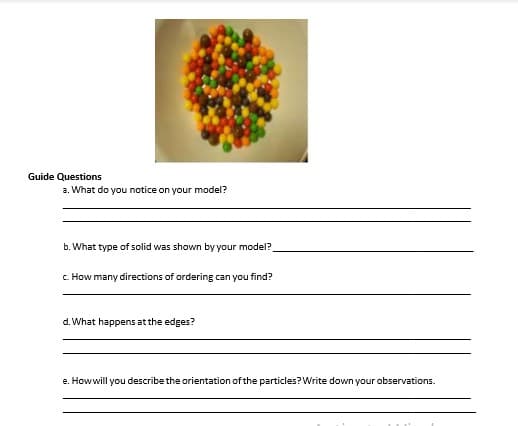2. Take the bowl with the small atoms and add the bigger atoms (the larger size candy). You do not need as manyof the bigger atoms, estimate one fourth to one third ofthe small atoms. Mixthe atoms with your hands until all the big atoms have been distributed. Again, gently shake the mixture and watch what happens to the atoms. The model should start to look something like the picture on the right.
2. Take the bowl with the small atoms and add the bigger atoms (the larger size candy). You do not need as manyof the bigger atoms, estimate one fourth to one third ofthe small atoms. Mixthe atoms with your hands until all the big atoms have been distributed. Again, gently shake the mixture and watch what happens to the atoms. The model should start to look something like the picture on the right.
Macroscale and Microscale Organic Experiments
7th Edition
ISBN:9781305577190
Author:Kenneth L. Williamson, Katherine M. Masters
Publisher:Kenneth L. Williamson, Katherine M. Masters
Chapter3: Melting Points And Boiling Points
Section: Chapter Questions
Problem 9Q: You have an unknown with an observed melting point of 90C-93C. Is your unknown compound A with a...
Related questions
Question

Transcribed Image Text:2. Take the bowl with the small atoms and add the bigger atoms (the larger size candy). You do
not need as manyof the bigger atoms, estimate one fourth to one third ofthe small atoms. Mixthe atoms
with your hands until all the big atoms have been distributed. Again, gently shake the mixture and watch
what happens to the atoms. The model should start to look something like the picture on the right.

Transcribed Image Text:Guide Questions
a. What do you notice on your model?
b. What type of solid was shown by your model?
c. How many directions of ordering can you find?
d. What happens at the edges?
e. Howwill you describe the orientation of the particles?Write down your observations.
Expert Solution
This question has been solved!
Explore an expertly crafted, step-by-step solution for a thorough understanding of key concepts.
This is a popular solution!
Trending now
This is a popular solution!
Step by step
Solved in 3 steps

Recommended textbooks for you

Macroscale and Microscale Organic Experiments
Chemistry
ISBN:
9781305577190
Author:
Kenneth L. Williamson, Katherine M. Masters
Publisher:
Brooks Cole

Organic Chemistry: A Guided Inquiry
Chemistry
ISBN:
9780618974122
Author:
Andrei Straumanis
Publisher:
Cengage Learning

Chemistry: Matter and Change
Chemistry
ISBN:
9780078746376
Author:
Dinah Zike, Laurel Dingrando, Nicholas Hainen, Cheryl Wistrom
Publisher:
Glencoe/McGraw-Hill School Pub Co

Macroscale and Microscale Organic Experiments
Chemistry
ISBN:
9781305577190
Author:
Kenneth L. Williamson, Katherine M. Masters
Publisher:
Brooks Cole

Organic Chemistry: A Guided Inquiry
Chemistry
ISBN:
9780618974122
Author:
Andrei Straumanis
Publisher:
Cengage Learning

Chemistry: Matter and Change
Chemistry
ISBN:
9780078746376
Author:
Dinah Zike, Laurel Dingrando, Nicholas Hainen, Cheryl Wistrom
Publisher:
Glencoe/McGraw-Hill School Pub Co

Chemistry for Today: General, Organic, and Bioche…
Chemistry
ISBN:
9781305960060
Author:
Spencer L. Seager, Michael R. Slabaugh, Maren S. Hansen
Publisher:
Cengage Learning


Chemistry by OpenStax (2015-05-04)
Chemistry
ISBN:
9781938168390
Author:
Klaus Theopold, Richard H Langley, Paul Flowers, William R. Robinson, Mark Blaser
Publisher:
OpenStax